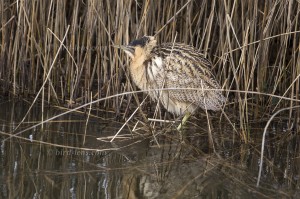 Great Bittern (Botaurus stellaris) has experienced its most successful year for breeding in Great Britain in 2016. At least, an annual national survey carried out by RSPB mentioned this. This is pointed out in an article in birdguides about the breeding success in the UK.
Great Bittern (Botaurus stellaris) has experienced its most successful year for breeding in Great Britain in 2016. At least, an annual national survey carried out by RSPB mentioned this. This is pointed out in an article in birdguides about the breeding success in the UK.
This breeding success is welcome news for these bulky brown-streaked herons, who’ve endured a tumultuous history in Britain and Ireland. In the late 19th century Bittern had vanished from Britain. They were prized as a medieval banquet dish and consequently hunted intensively. The loss of their reedbed habitat contributed to their decline.
Bittern started to re-colonize England at the beginning of the twentieth century, but due to the continuing loss of habitat, their numbers declined from the middle of the century. By 1997, there were only 11 territorial males across the country
To mark their territory and advertise themselves to potential partners, male Bitterns make a distinctive ‘booming’ sound in the breeding season. Scientists count Bitterns by listening for the male’s foghorn-like ‘booming’ call. Usually this indicates the holding of a breeding territory. In year 2016 numbers increased to at least 161 recorded ‘booming’ males at 76 sites. That compares to 157 at 72 sites in 2015.
A highlight in 2016 was the discovery of two nests on Otmoor, Oxfordshire — the first time they have been confirmed nesting at this site. Meanwhile in Wales, the first nest for over 30 years was found at Malltraeth Marsh RSPB, Anglesey.
In the late 1990s, Bittern experienced a severe decline, mainly because its preferred habitat – wet, extensive reedbeds — were drying out and required intensive management, restoration and habitat recreation to restore the original condition. Thanks to the careful management of reedbeds across the country, the habitat could obviously be made so attractive that more and more Bitterns could be observed as a result. That shows that conservation really can make a difference in bringing a species back from the brink of extinction.
To cope with the growing demand for top shots of the rarer species of the Palearctic Bird-Lens is keen to enrich the range of pictures of birds you can find in the Western Palearctic. Trips to remote places to capture images of rare birds of Western Palearctic were very successful. The nice images you find in the gallery are only a first impression, what you will find in the gallery in the “Picture Shop” very soon. Just give me a message, if bird-lens.com could serve you with an image needed before the new pictures are online.